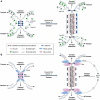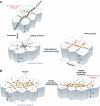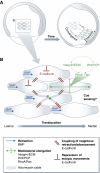Spatial organization of adhesion: force-dependent regulation and function in tissue morphogenesis
- PMID: 20717145
- PMCID: PMC2924654
- DOI: 10.1038/emboj.2010.182
Spatial organization of adhesion: force-dependent regulation and function in tissue morphogenesis
Abstract
Integrin- and cadherin-mediated adhesion is central for cell and tissue morphogenesis, allowing cells and tissues to change shape without loosing integrity. Studies predominantly in cell culture showed that mechanosensation through adhesion structures is achieved by force-mediated modulation of their molecular composition. The specific molecular composition of adhesion sites in turn determines their signalling activity and dynamic reorganization. Here, we will review how adhesion sites respond to mecanical stimuli, and how spatially and temporally regulated signalling from different adhesion sites controls cell migration and tissue morphogenesis.
Conflict of interest statement
The authors declare that they have no conflict of interest.
Figures





Similar articles
-
Force transduction by cadherin adhesions in morphogenesis.F1000Res. 2019 Jul 10;8:F1000 Faculty Rev-1044. doi: 10.12688/f1000research.18779.1. eCollection 2019. F1000Res. 2019. PMID: 31327995 Free PMC article. Review.
-
Adhesion remodeling underlying tissue morphogenesis.Trends Cell Biol. 2005 Jan;15(1):34-42. doi: 10.1016/j.tcb.2004.11.007. Trends Cell Biol. 2005. PMID: 15653076 Review.
-
Feeling the force: Multiscale force sensing and transduction at the cell-cell interface.Semin Cell Dev Biol. 2021 Dec;120:53-65. doi: 10.1016/j.semcdb.2021.06.006. Epub 2021 Jul 6. Semin Cell Dev Biol. 2021. PMID: 34238674 Review.
-
Mechanosensing in embryogenesis.Curr Opin Cell Biol. 2021 Feb;68:1-9. doi: 10.1016/j.ceb.2020.08.007. Epub 2020 Sep 6. Curr Opin Cell Biol. 2021. PMID: 32898827 Review.
-
Cell adhesion: the molecular basis of tissue architecture and morphogenesis.Cell. 1996 Feb 9;84(3):345-57. doi: 10.1016/s0092-8674(00)81279-9. Cell. 1996. PMID: 8608588 Review.
Cited by
-
Smooth muscle tension induces invasive remodeling of the zebrafish intestine.PLoS Biol. 2012;10(9):e1001386. doi: 10.1371/journal.pbio.1001386. Epub 2012 Sep 4. PLoS Biol. 2012. PMID: 22973180 Free PMC article.
-
Mechanosensitivity and compositional dynamics of cell-matrix adhesions.EMBO Rep. 2013 Jun;14(6):509-19. doi: 10.1038/embor.2013.49. Epub 2013 May 17. EMBO Rep. 2013. PMID: 23681438 Free PMC article. Review.
-
How Tissue Mechanical Properties Affect Enteric Neural Crest Cell Migration.Sci Rep. 2016 Feb 18;6:20927. doi: 10.1038/srep20927. Sci Rep. 2016. PMID: 26887292 Free PMC article.
-
Role of differential adhesion in cell cluster evolution: from vasculogenesis to cancer metastasis.Comput Methods Biomech Biomed Engin. 2015;18(3):282-92. doi: 10.1080/10255842.2013.792917. Epub 2013 May 8. Comput Methods Biomech Biomed Engin. 2015. PMID: 23656190 Free PMC article.
-
Focusing on Mechanoregulation Axis in Fibrosis: Sensing, Transduction and Effecting.Front Mol Biosci. 2022 Mar 11;9:804680. doi: 10.3389/fmolb.2022.804680. eCollection 2022. Front Mol Biosci. 2022. PMID: 35359592 Free PMC article. Review.
References
-
- Anastasiadis PZ, Moon SY, Thoreson MA, Mariner DJ, Crawford HC, Zheng Y, Reynolds AB (2000) Inhibition of RhoA by p120 catenin. Nat Cell Biol 2: 637–644 - PubMed
-
- Arboleda-Estudillo Y, Krieg M, Stuhmer J, Licata NA, Muller DJ, Heisenberg CP (2010) Movement directionality in collective migration of germ layer progenitors. Curr Biol 20: 161–169 - PubMed
Publication types
MeSH terms
LinkOut - more resources
Full Text Sources
Other Literature Sources

